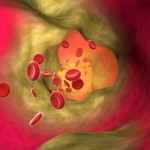Taxanes, including docetaxel, are widely used for the treatment of squamous cell carcinoma of the head and neck. However, the gastrointestinal toxicity of docetaxel has limited its high-dose clinical use. In this study, we examined the synergistic anticancer effects of combined low-dose docetaxel and gamma-tocotrienol treatment on human oral cancer (B88) cells. We treated B88 cells with docetaxel and gamma-tocotrienol at concentrations of 0.5 nM and 50 microM, respectively. When cells were treated with either agent alone at a low dose, no significant cytotoxic effect was observed. However, the simultaneous treatment of cells with both agents almost completely suppressed cell growth. Whereas docetaxel stimulated the expression of nuclear factor-kappaB (NF-kappaB) p65 protein in B88 cells, gamma-tocotrienol slightly inhibited the expression of constitutive nuclear p65 protein. Of note, the combined treatment with both agents inhibited docetaxel-induced nuclear p65 protein expression. Electrophoretic mobility shift assay (EMSA) revealed that the simultaneous treatment with these agents suppressed the NF-kappaB DNA binding activity in B88 cells. In addition, gamma-tocotrienol downregulated the docetaxel-induced expression of NF-kappaB-regulated gene products associated with the inhibition of apoptosis. Furthermore, the activation of initiator caspases, caspases-8 and -9, and the effector caspase, caspase-3, was detected following treatment with both agents. Finally, apoptosis was also clearly observed as demonstrated by the cleavage of poly(ADP-ribose) polymerase (PARP) and nuclear fragmentation through the activation of caspase-3 by combined treatment with docetaxel and gamma-tocotrienol. These findings suggest that the combination treatment with these agents may provide enhanced therapeutic response in oral cancer patients, while avoiding the toxicity associated with high-dose beta-tubulin stabilization monotherapy.
Blog Archives
Gamma-tocotrienol reduces the triacylglycerol level in rat primary hepatocytes through regulation of fatty acid metabolism
Muto C, Yachi R, Aoki Y, et al
J Clin Biochem Nutr. 2013 Jan;52(1):32-7
The present study was carried out to investigate the effect of vitamin E analogs, especially gamma-tocotrienol (gamma-T3), on hepatic TG accumulation and enzymes related to fatty acid metabolism in three types of rat primary hepatocytes: (1) normal hepatocytes, (2) hepatocytes incubated in the presence of palmitic acid (PA), and (3) hepatocytes with fat accumulation. Our results showed that gamma-T3 significantly reduced the TG content of normal hepatocytes. gamma-T3 also increased the expression of carnitine palmitoyltransferase 1 (CPT1A) mRNA, and tended to reduce that of sterol regulatory element binding protein 1c (SREBP-1c) mRNA. In addition, gamma-T3 markedly suppressed the gene expression of both C/EBP homologous protein (CHOP) and SREBP-1c induced by PA. As these two genes are located downstream of endoplasmic reticulum (ER) stress, their suppression by gamma-T3 might result from a decrease of ER stress. Moreover, gamma-T3 suppressed the expression of interleukin 1beta (IL-1beta), which lies downstream of CHOP signaling. Taken together, our data suggest that gamma-T3 might prevent hepatic steatosis and ameliorate ER stress and subsequent inflammation in the liver.
Mitochondrial-dependent anticancer activity of delta-tocotrienol and its synthetic derivatives in HER-2/neu overexpressing breast adenocarcinoma cells
Viola V, Ciffolilli S, Legnaioli, S et al
Biofactors; epub Jan30,2013
Anticancer activity and mitochondrial mechanism of the vitamin E form delta-tocotrienol (delta-T3) was investigated in HER-2/neu-overexpressing human SKBR3 and murine TUBO breast cancer cells. delta-T3 was confirmed to possess high cytotoxic and apoptotic activity in SKBR3 cells as compared with all natural forms of vitamin E and several synthetic forms that included novel derivatives with the same backbone of delta-T3 such as delta-tocotrienyl-succinyl amide (delta-T3AS) and the redox-active analogue delta-tocotrienyl amine (delta-T3NH2). As observed in the case of alpha-TOS, a prototypical anticancer drug derived from alpha-tocopherol, succinylation of delta-T3 enhanced citotoxicity and apoptotic activity of the vitamer. delta-T3 induced apoptosis of SKBR3 cells was associated with mitochondrial destabilization, energy failure, and unbalanced activity of stress/survival MAPKs, namely p38 and ERK1/2 pathways. An increased generation of ROS followed to such a series of early events. Enhanced activity of delta-T3 in this human carcinoma cell line was characterized by the sustained uptake and oxidative transformation to the quinone derivative delta-T3Q, thereby suggesting redox effects in SKBR3 mitochondria by this vitamer. Viability and uptake data show a different pattern of responses in TUBO cells with higher response to synthetic derivatives of delta-T3 than in SKBR3 cells. In conclusion, synthetic derivatives of delta-T3 with enhanced apoptotic activity in breast carcinoma cells are investigated for the first time in this study also describing mechanistic aspects of mitochondrial effects of delta-T3. Further investigation in preclinical models of HER2/neu-high breast adenocarcinoma is underway to identify other and more effective forms of VE in this type of cancer.
Vitamin E delta-Tocotrienol Induces p27(Kip1)-Dependent Cell-Cycle Arrest in Pancreatic Cancer Cells via an E2F-1-Dependent Mechanism
Hodul, PJ Dong Y, Husain K et al
PLoS One,2013;8(2):e52526
Vitamin E delta-tocotrienol has been shown to have antitumor activity, but the precise molecular mechanism by which it inhibits the proliferation of cancer cells remains unclear. Here, we demonstrated that delta-tocotrienol exerted significant cell growth inhibition pancreatic ductal cancer (PDCA) cells without affecting normal human pancreatic ductal epithelial cell growth. We also showed that delta-tocotrienol-induced growth inhibition occurred concomitantly with G(1) cell-cycle arrest and increased p27(Kip1) nuclear accumulation. This finding is significant considering that loss of nuclear p27(Kip1) expression is a well-established adverse prognostic factor in PDCA. Furthermore, delta-tocotrienol inactivated RAF-MEK-ERK signaling, a pathway known to suppress p27(Kip1) expression. To determine whether p27(Kip1) induction is required for delta-tocotrienol inhibition of PDCA cell proliferation, we stably silenced the CDKN1B gene, encoding p27(Kip1), in MIAPaCa-2 PDCA cells and demonstrated that p27(Kip1) silencing suppressed cell-cycle arrest induced by delta-tocotrienol. Furthermore, delta-tocotrienol induced p27(Kip1) mRNA expression but not its protein degradation. p27(Kip1) gene promoter activity was induced by delta-tocotrienol through the promoter’s E2F-1 binding site, and this activity was attenuated by E2F-1 depletion using E2F-1 small interfering RNA. Finally, decreased proliferation, mediated by Ki67 and p27(Kip1) expression by delta-tocotrienol, was confirmed in vivo in a nude mouse xenograft pancreatic cancer model. Our findings reveal a new mechanism, dependent on p27(Kip1) induction, by which delta-tocotrienol can inhibit proliferation in PDCA cells, providing a new rationale for p27(Kip1) as a biomarker for delta-tocotrienol efficacy in pancreatic cancer prevention and therapy.
Classification and prediction of clinical diagnosis of Alzheimer’s disease based on MRI and plasma measures of α-/γ-tocotrienols and γ-tocopherol
Mangialasche F, Westman E, Kivipelto M, et al
J Intern Med. 2013 Jan 24. doi: 10.1111/joim.12037. [Epub ahead of print]
Published
OBJECTIVES:The aim of this study was to evaluate the accuracy of combined structural magnetic resonance imaging (MRI) measures and plasma levels of vitamin E forms, including all eight natural vitamin E congeners (four tocopherols and four tocotrienols) and markers of vitamin E oxidative/nitrosative damage, in differentiating individuals with Alzheimer’s disease (AD) and mild cognitive impairment (MCI) from cognitively intact control (CTL) subjects.
SUBJECTS AND DESIGN: Overall, 81 patients with AD, 86 with MCI and 86 CTL individuals were enrolled from the longitudinal multicentre AddNeuroMed study. MRI and plasma vitamin E data were acquired at baseline. MRI scans were analysed using Freesurfer, an automated segmentation scheme which generates regional volume and cortical thickness measures. Orthogonal partial least squares to latent structures (OPLS), a multivariate data analysis technique, was used to analyse MRI and vitamin E measures in relation to AD and MCI diagnosis.
RESULTS: The joint evaluation of MRI and plasma vitamin E measures enhanced the accuracy of differentiating individuals with AD and MCI from CTL subjects: 98.2% (sensitivity 98.8%, specificity 97.7%) for AD versus CTL and 90.7% (sensitivity 91.8%, specificity 89.5%) for MCI versus CTL. This combination of measures also identified 85% of individuals with MCI who converted to clinical AD at follow-up after 1 year.
CONCLUSIONS: Plasma levels of tocopherols and tocotrienols together with automated MRI measures can help to differentiate AD and MCI cases from CTL subjects, and to prospectively predict MCI conversion to AD. Our results suggest the potential role of nutritional biomarkers detected in plasma – tocopherols and tocotrienols – as indirect indicators of AD pathology, and the utility of a multimodality approach. © 2013 The Association for the Publication of the Journal of Internal Medicine.
The Dr Oz Show Explains Health Benefits of Red Palm Oil Particularly Due to its Tocotrienols
 The Dr Oz Show, a widely followed television series focusing on personal health and integrative medicine hosted by multi-awarded heart surgeon Dr Oz, recently presented its views on the health benefits of red palm oil from the fruit of the oil palm tree (Elais guineensis).
The Dr Oz Show, a widely followed television series focusing on personal health and integrative medicine hosted by multi-awarded heart surgeon Dr Oz, recently presented its views on the health benefits of red palm oil from the fruit of the oil palm tree (Elais guineensis).
In the show’s January 3, 2013 episode, Dr Oz and his guest, Bryce Wylde, recommend red palm oil particularly for its tocotrienol, a novel form of vitamin E found in the oil palm fruit. On his show Dr Oz called the red palm oil as the “most miraculous find of 2013”. According to Dr. Oz, tocotrienols possess stellar antioxidation properties and unique health benefits that support heart and brain health.
Sesamin synergistically potentiates the anticancer effects of γ-tocotrienol in mammary cancer cell lines
Akl MR, Ayoub NM, Abuasal BS, Kaddoumi A, Sylvester PW.
Fitoterapia. 2013 Jan;84:347-59.
Summary
γ-Tocotrienol and sesamin are phytochemicals that display potent anticancer activity. Since sesamin inhibits the metabolic degradation of tocotrienols, studies were conducted to determine if combined treatment with sesamin potentiates the antiproliferative effects of γ-tocotrienol on neoplastic mouse (+ SA) and human (MCF-7 and MDA-MB-231) mammary cancer cells. Results showed that treatment with γ-tocotrienol or sesamin alone induced a significant dose-responsive growth inhibition, whereas combination treatment with these agents synergistically inhibited the growth of + SA, MCF-7 and MDA-MB-231 mammary cancer cells, while similar treatment doses were found to have little or no effect on normal (mouse CL-S1 and human MCF-10A) mammary epithelial cell growth or viability. However, sesamin synergistic enhancement of γ-tocotrienol-induced anticancer effects was not found to be mediated from a reduction in γ-tocotrienol metabolism. Rather, combined treatment with subeffective doses of γ-tocotrienol and sesamin was found to induce G1 cell cycle arrest, and a corresponding decrease in cyclin D1, CDK2, CDK4, CDK6, phospho-Rb, and E2F1 levels, and increase in p27 and p16 levels. Additional studies showed that the antiproliferative effect of combination treatment did not initiate apoptosis or result in a decrease in mammary cancer cell viability. Taken together, these findings indicate that the synergistic antiproliferative action of combined γ-tocotrienol and sesamin treatment in mouse and human mammary cancer cells is cytostatic, not cytotoxic, and results from G1 cell cycle arrest.
Effects of Tocotrienol-Enriched Fraction of Palm Oil of Serum Lipids in Hypercholesterolemic Subjects
David Heber, Center for Human Nutrition, UCLA
Terminated
Objective: To evaluate cholesterol-suppressive actions of tocotrienol-enriched fractions in hypercholesterolemic human subjects.
Study Type:Interventional
Study Design: Randomized, double-blind, placebo-controlled
Subjects: Hypercholesterolemic subjects
Intervention: Gamma-Delta Tocotrienol (63 mg and 127 mg; Davos Life Science Pte Ltd)
Primary Outcome:
- Fasting cholesterol levels [time frame: baseline, 4, 8, 12 weeks]
- Total body fat [time frame: baseline, 4, 8 12 weeks]
Secondary Outcome:
- Genetic biomarkers for lipid metabolism
Methodology:
The cholesterol suppressive actions of tocotrienol-enriched formulations will be assessed in 99 hypercholesterolemic subjects 37 – 70 years of age, During a two-week run-in period, subjects will be asked to follow the American Heart Association Step 1 dietary regimen and to take a placebo capsule twice daily to determine their ability to comply with the diet and pill regimen. Their fasting cholesterol levels will be tested again after the two-week run-in period.
At this point, they will be randomly assigned to take either a placebo capsule or tocotrienol twice daily. Subjects will have body weight, waist circumference, fasting lipids and other biomarkers measured at 0, 4, 8 and 12 weeks
More Using Palm Oil Vitamin E
Ooi Tee Ching
 A Life Saver: As more medical researchers all over the world discover the unique ability of palm oil vitamin E in seeking and killing cancer cells, Malaysia steps up funding for such studies in the hope of saving more lives.
A Life Saver: As more medical researchers all over the world discover the unique ability of palm oil vitamin E in seeking and killing cancer cells, Malaysia steps up funding for such studies in the hope of saving more lives.
Over the last 30 years, scientific studies have shown that palm oil vitamin E, particularly the tocotrienols, is a far more potent antioxidant than tocopherols.
Vitamin E Tocotrienol Recognized for Cardiovascular and Metabolic Support
Numerous studies over the past two decades have clearly proven that the tocotrienol form of vitamin E is a top choice for cardiovascular protection and heart health. A recent review of tocotrienol science points out that they are also being researched for benefits to bone health, blood sugar metabolism, brain health, and cancer. Tocotrienols offer a safe and effective way to help achieve or maintain healthy cholesterol, while simultaneously protecting your arteries. It is worthwhile understanding more about them and how they can improve your health.

